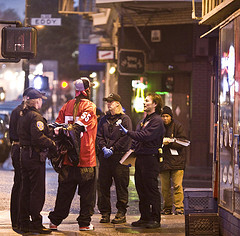 The New York Sun recently reported on the release of a new study from sociologist Harry Levin of Queens College titled, “Marijuana Arrest Crusade.” The report claims that police have singled-out minorities during the drug crackdown in New York beginning in 1997. The study makes use of data from the New York Division of Criminal Justice Services which shows that between 1997 and 2007, of those arrested on drugs charges, 52% of the suspects were black, 31% Hispanic, and only 15% white.
The New York Sun recently reported on the release of a new study from sociologist Harry Levin of Queens College titled, “Marijuana Arrest Crusade.” The report claims that police have singled-out minorities during the drug crackdown in New York beginning in 1997. The study makes use of data from the New York Division of Criminal Justice Services which shows that between 1997 and 2007, of those arrested on drugs charges, 52% of the suspects were black, 31% Hispanic, and only 15% white.
Some blame laws…
“Laws were revised in the late 1970s to largely decriminalize carrying small, concealed stashes of marijuana, Mr. Levin said. But he claimed police routinely ‘manufacture’ arrests for possession in public view — still a misdemeanor — by stopping young black men on the street and goading them into emptying their pockets.”
Others blame the administration…
“According to the study, arrests for marijuana possession began skyrocketing in the late 1990s during the Giuliani administration — a trend that continued under Mayor Bloomberg at an estimated cost of between $50 and $90 million a year. There were 39,700 arrests last year alone, according to the study. The 2007 total makes the city ‘the marijuana arrest capital of the world,’ Ms. Lieberman [the Executive Director of the New York Civil Liberties Union] said.”

 In a new editorial from the
In a new editorial from the  A new report from the
A new report from the